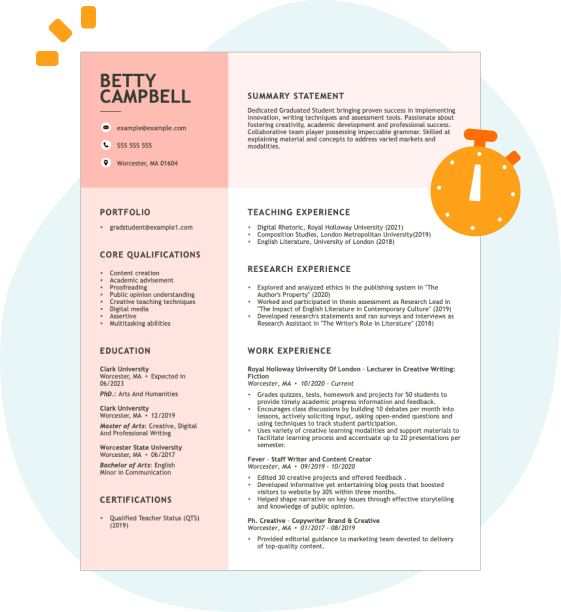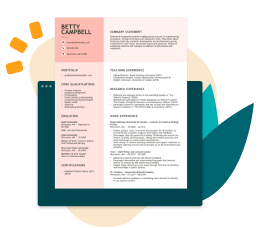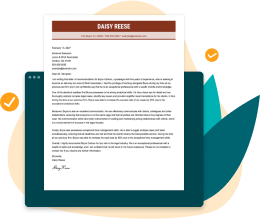Hard skills include skill in healthcare administration systems, data management, and regulatory compliance that ensure efficient operations within a healthcare setting.
Popular Administrator Resume Examples
Discover our top administrator resume examples that emphasize key skills such as organization, leadership, and problem-solving. These examples will help you effectively highlight your accomplishments to catch the eye of potential employers.
Looking to build your own exceptional resume? The Resume Builder offers user-friendly templates designed specifically for administrative professionals, making it simpler than ever to showcase your qualifications.
Entry-level administrator resume
This entry-level resume for an administrator highlights the applicant's leadership abilities and significant achievements in operational efficiency, demonstrating a capacity for managing teams and driving productivity improvements. New professionals in this field must showcase their relevant skills and accomplishments effectively, even with limited work history, to reassure employers of their potential contributions.
Mid-career administrator resume
This resume skillfully presents key qualifications that showcase the job seeker's leadership and operational expertise. By highlighting measurable achievements and progressive responsibilities, it clearly illustrates readiness for higher-level administrative roles and complex challenges in business management.
Experienced administrator resume
This resume's work history section demonstrates the applicant's robust experience in administration, particularly their successes in budget management and process improvement. The quantifiable achievements, such as saving 15% on budgets and boosting team efficiency by 40%, are clearly presented, improving readability for hiring managers.
Resume Template—Easy to Copy & Paste
Ming Johnson
St. Louis, MO 63101
(555)555-5555
Ming.Johnson@example.com
Skills
- Organizational Management
- Strategic Planning
- Process Improvement
- Team Leadership
- Compliance Auditing
- Performance Metrics Analysis
- Budget Management
- Staff Training and Development
Languages
- Spanish - Beginner (A1)
- French - Beginner (A1)
- German - Intermediate (B1)
Professional Summary
Experienced Administrator with 6+ years managing operations, compliance, and teams. Proven ability to streamline processes, reduce costs, and drive efficiency by over 20%. Expertise in organizational management, strategic planning, and performance optimization.
Work History
Administrator
Global Management Solutions - St. Louis, MO
September 2022 - September 2025
- Streamlined operations, reducing overhead by 15%.
- Oversaw compliance audits for 10+ departments.
- Implemented new processes, boosting efficiency by 20%.
Operations Manager
BrightPath Consulting Group - Parkview, MO
September 2019 - August 2022
- Directed cross-functional teams, saving 250k annually.
- Supervised staff training, increasing productivity by 10%.
- Managed budgets exceeding 2M for key projects.
Office Coordinator
VisionTech Solutions - Parkview, MO
September 2017 - August 2019
- Scheduled operations, reducing delays by 25%.
- Maintained vendor relationships, cutting costs by 12%.
- Organized reports, improving accuracy by 30%.
Certifications
- Certified Administrator Professional - National Administrator Association
- Lean Six Sigma Green Belt - Six Sigma Institute
Education
Master's Degree Business Administration
Columbia University New York, NY
May 2017
Bachelor's Degree Management
University of Massachusetts Boston, MA
May 2015
How to Write an Administrator Resume Summary
Your resume summary is the first opportunity to catch employers' attention, making it essential to showcase your qualifications effectively. As an administrator, you should highlight your organizational skills, attention to detail, and ability to manage multiple tasks efficiently. To illustrate what makes a compelling summary, here are some examples that will clarify what resonates with hiring managers and what may fall flat:
Weak resume summary
I am a dedicated administrator with extensive experience in various office settings. I seek a position that allows me to use my organizational skills and contribute positively to the team. An ideal job would offer stability and potential for advancement, where I can thrive professionally.
- Lacks specific achievements or skills that highlight the job seeker's value
- Emphasizes personal desires over what they can bring to the company
- Contains generic phrases that do not stand out or convey unique qualifications
Strong resume summary
Results-driven administrator with over 7 years of experience in healthcare management, focusing on optimizing operational efficiency and patient satisfaction. Achieved a 20% increase in departmental productivity through streamlined processes and staff training initiatives. Proficient in budget management, regulatory compliance, and implementing electronic health record systems to improve service delivery.
- Begins with a clear indication of years of experience and area of expertise
- Highlights quantifiable achievements that illustrate powerful contributions to the organization
- Showcases relevant skills that align with the responsibilities typically expected from an administrator
PRO TIP
Showcasing Your Work Experience
The work experience section in your radministrator resume is where you’ll have the bulk of your content. Good resume templates always emphasize this important area to capture attention.
This section should be organized in reverse-chronological order, detailing your previous roles and responsibilities. Use bullet points to highlight key achievements and contributions that showcase your effectiveness.
To illustrate what makes a strong work history entry for administrators, we will share examples that demonstrate both effective strategies and common pitfalls.
Administrator
XYZ Corp – New York, NY
- Handled office tasks
- Assisted visitors and staff
- Managed schedules and meetings
- Performed data entry and filing
- Lacks specific employment dates
- Bullet points describe basic responsibilities without showcasing skills or impact
- No measurable achievements or contributions to the organization are mentioned
Administrator
Tech Solutions Inc. – San Francisco, CA
March 2020 - Present
- Streamlined office operations by implementing a new digital filing system, reducing document retrieval time by 40%
- Coordinated team schedules and resources for multiple projects, ensuring deadlines were met with a 95% on-time completion rate
- Developed training materials for onboarding new staff, improving the onboarding process efficiency by 30%
- Starts each bullet point with strong action verbs that highlight key achievements
- Incorporates specific metrics to illustrate the impact of contributions clearly
- Emphasizes relevant skills such as organization and project management in context
While your resume summary and work experience are important components, it's important not to overlook other sections that contribute to a polished presentation. For detailed guidance on constructing an effective resume, be sure to explore our comprehensive guide on how to write a resume.
Top Skills to Include on Your Resume
Including a skills section on your resume is important for making a strong first impression. It allows hiring managers to quickly identify your qualifications and assess if you’re the right fit for the role.
As an administrator, you've got to ensure you showcase a balanced mix of soft and hard skills. To differentiate hard skills from soft skills, remember that hard skills pertain to specialized knowledge for the role. On the other hand, soft skills are more innate abilities that show how you work and collaborate with other team members.
Soft skills encompass strong communication, leadership, and problem-solving abilities, which are essential for fostering teamwork and improving patient care experiences.
Choosing the right resume skills helps you align with the employer's expectations for job seekers. Many organizations use automated screening systems that filter out applicants who lack essential skills, so tailoring your skills is important.
To effectively highlight your qualifications, carefully review job postings related to your desired position. These listings often reveal specific skills prioritized by recruiters and ATS systems, helping you present a compelling application that stands out.
PRO TIP
10 skills that appear on successful administrator resumes
Highlighting in-demand skills on your resume is important for grabbing the attention of recruiters. These key abilities not only demonstrate your qualifications but also show that you are aligned with industry needs. For inspiration, our resume examples effectively illustrate these skills and can help you present yourself confidently to potential employers.
Consider including the following 10 skills in your resume if they align with your experience and job requirements:
Project management
Attention to detail
Time management
Interpersonal communication
Problem-solving
Technical skill
Data analysis
Customer service expertise
Team collaboration
Adaptability
Based on analysis of 5,000+ administrative professional resumes from 2023-2024
Resume Format Examples
Selecting the appropriate resume format helps administrators clearly showcase key skills and experiences, allowing potential employers to easily see your qualifications and career growth.
Functional
Focuses on skills rather than previous jobs
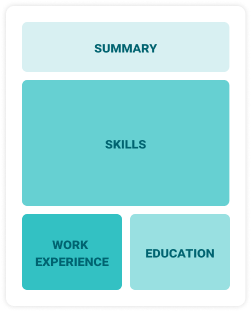
Best for:
Recent graduates and career changers with little to no experience
Combination
Balances skills and work history equally
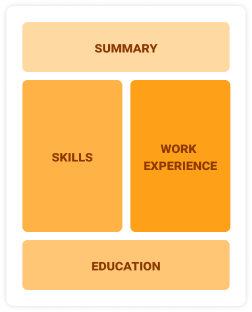
Best for:
Mid-career professionals focused on demonstrating their skills and potential for growth
Chronological
Emphasizes work history in reverse order

Best for:
Seasoned leaders driving innovation in healthcare administration
Typical Administrator Salaries in Popular States
Our administrator salary data is based on figures from the U.S. Bureau of Labor Statistics (BLS), the authoritative source for employment trends and wage information nationwide.
Whether you're entering the workforce or considering a move to a new city or state, this data can help you gauge what fair compensation looks like for administrators in your desired area.
Frequently Asked Questions
Should I include a cover letter with my administrator resume?
Absolutely! Including a cover letter can significantly improve your job application by showcasing your personality and providing context for your achievements. It allows you to express genuine interest in the position. If you're looking for assistance, explore our resources on how to write a cover letter or use our Cover Letter Generator to create one effortlessly.
Can I use a resume if I’m applying internationally, or do I need a CV?
When applying for jobs outside the U.S., a CV is often required instead of a resume. A CV provides a comprehensive overview of your academic and professional history. For guidance on how to write a CV with effective formatting, explore our collection of CV examples designed to assist job seekers globally.
What soft skills are important for administrators?
Soft skills such as interpersonal skills, communication, problem-solving, and leadership are essential for administrators. These abilities foster collaboration among team members and help in resolving conflicts effectively, which ultimately leads to a more productive and harmonious work environment.
I’m transitioning from another field. How should I highlight my experience?
Highlight your transferable skills such as organization, communication, and adaptability from previous roles. These abilities showcase your potential value in an administrator position, even if your experience is limited in that specific field. Use concrete examples to illustrate how your past successes align with the responsibilities of administration and demonstrate your readiness to excel.
How should I format a cover letter for a administrator job?
To format a cover letter effectively, begin with your contact details and date, followed by a professional greeting. Next, craft an engaging introduction that highlights your interest in the administrator role. Include a concise overview of your relevant skills and experiences. Always tailor each letter to align with the job requirements, and conclude with a strong closing statement inviting further discussion.
How do I add my resume to LinkedIn?
To increase your resume's visibility on LinkedIn, you can add your resume to LinkedIn by uploading it to your profile. Additionally, highlight key skills and achievements in the "About" and "Experience" sections. This approach not only showcases your qualifications but also helps recruiters and hiring managers easily find potential job seekers like you.


